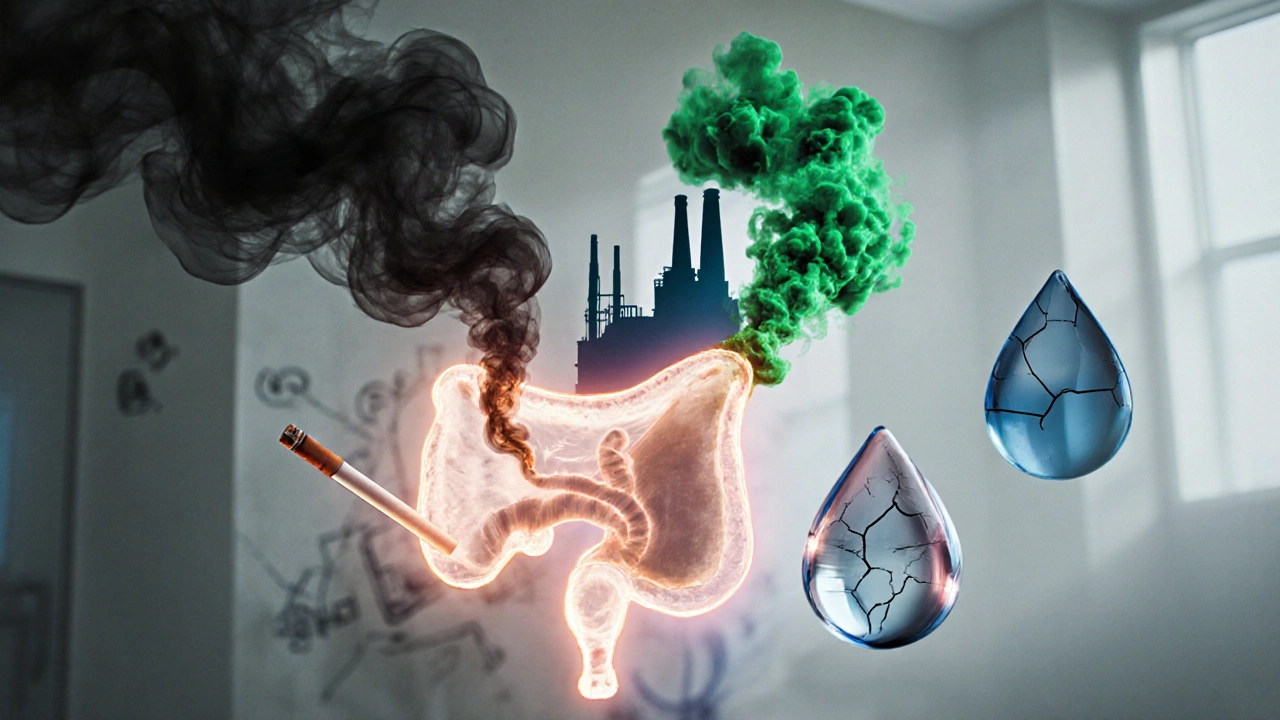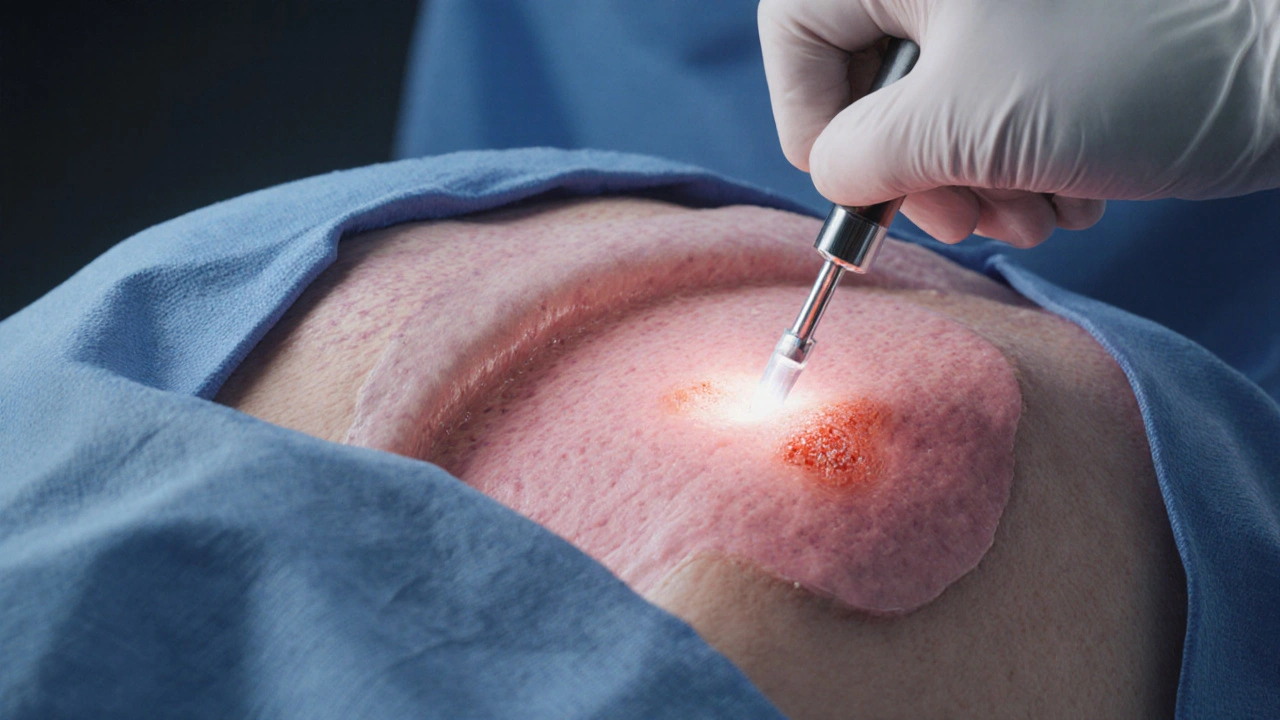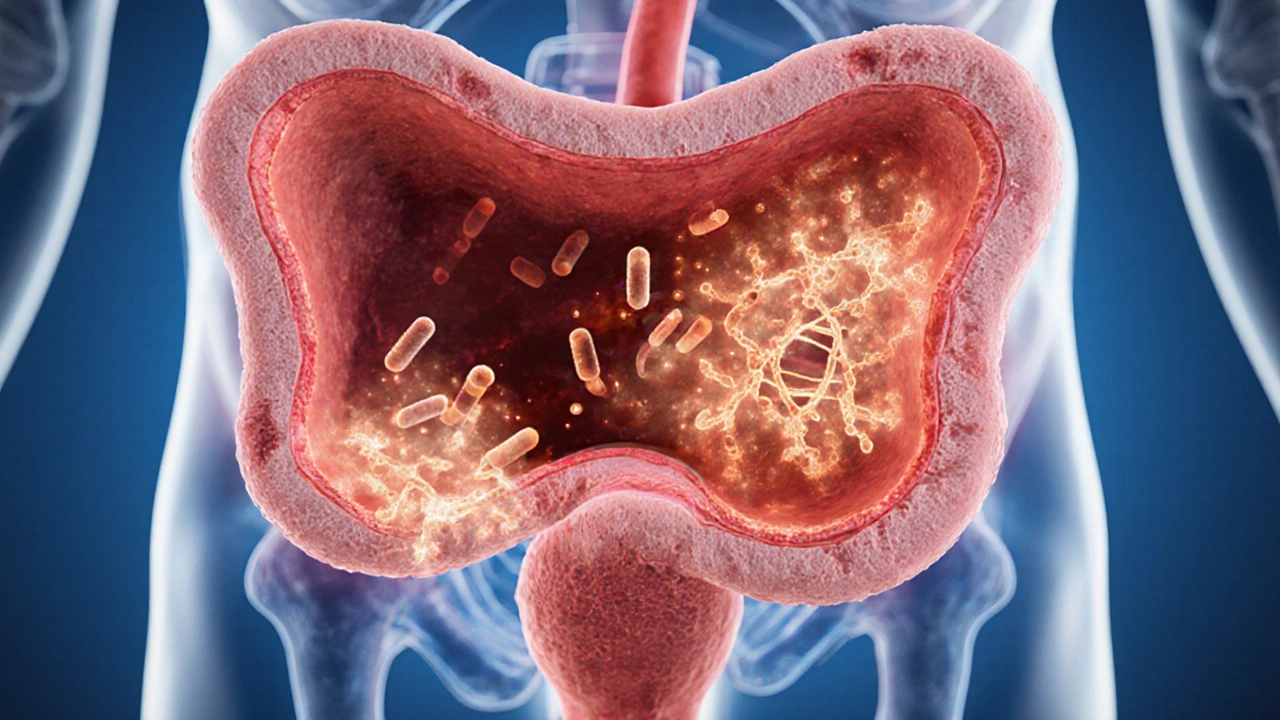Cystitis to Bladder Cancer Risk Calculator
Your Risk Assessment
Understanding Your Risk Factors
Cystitis Episodes
Smoking Status
Age
Occupational Exposure
Ever wondered why a simple urinary tract infection could turn into something far more serious? While most cases of cystitis resolve with a short course of antibiotics, researchers have uncovered a subtle but important link between repeated bladder inflammation and the development of bladder cancer. This article breaks down what that link looks like, who should pay extra attention, and what steps can keep the risk low.
Key Takeaways
- Chronic or recurrent cystitis can increase the risk of urothelial (bladder) cancer, especially in smokers.
- Inflammation triggers DNA damage and cellular changes that may evolve into malignancy over years.
- Early detection through urine tests and cystoscopy is crucial for high‑risk patients.
- Lifestyle changes-quitting smoking, staying hydrated, and treating infections promptly-significantly cut risk.
- Regular follow‑up with a urologist is recommended for anyone with persistent bladder symptoms.
What Is Cystitis?
Cystitis is a type of urinary tract infection (UTI) that specifically inflames the bladder lining. It’s most often caused by Escherichia coli bacteria entering the urethra and traveling up to the bladder. Symptoms include burning during urination, frequent urges, and lower‑abdominal pain. While a single episode is usually harmless, repeated bouts can scar the bladder mucosa and set the stage for more serious problems.
Understanding Bladder Cancer
Bladder cancer refers to malignant growths that arise from the bladder’s lining, known as the urothelium. The most common form, urothelial carcinoma, accounts for about 90% of cases. Early‑stage disease often presents with painless hematuria (blood in the urine), while advanced stages can cause pelvic pain, urinary obstruction, or weight loss.
How Chronic Inflammation Bridges the Gap
Inflammation isn’t just a symptom-it’s a driver of cellular change. When the bladder lining is repeatedly irritated by cystitis, immune cells release reactive oxygen species (ROS) and cytokines. These molecules can damage DNA, leading to mutations in key genes like TP53 and FGFR3. Over time, the bladder’s repair mechanisms may go awry, allowing mutated cells to proliferate unchecked-a hallmark of cancer development.

What the Evidence Says
Large epidemiological studies from the United States, Europe, and Asia consistently show a modest but statistically significant rise in bladder cancer incidence among people with a history of chronic cystitis. One 2022 cohort study tracked 150,000 adults for ten years and found that those with three or more documented cystitis episodes had a 1.7‑fold higher risk of developing bladder cancer compared to those with no infections. The risk amplified further in smokers, reaching a 3‑fold increase.
Who’s Most at Risk?
Not everyone with a urinary infection will face cancer risk, but certain factors tip the scales:
- Smoking: Tobacco smoke introduces carcinogens that accumulate in the urinary tract, compounding inflammation‑driven damage.
- Occupational exposure: Jobs involving aromatic amines (e.g., dye, rubber, leather) raise baseline risk.
- Genetic predisposition: Families with a history of urothelial carcinoma often carry mutations that impair DNA repair.
- Poor hydration: Concentrated urine irritates the bladder lining and slows bacterial clearance.
- Gender: Men are diagnosed more often, but women with recurrent cystitis may experience diagnostic delays.
Spotting the Warning Signs Early
Because bladder cancer can masquerade as a urinary infection, clinicians recommend a layered diagnostic approach for high‑risk patients:
- Urine cytology: Checks for abnormal cells shed into the urine.
- Cystoscopy: Direct visual inspection of the bladder interior using a thin camera. Biopsies are taken if suspicious lesions appear.
- Imaging: CT urography helps assess tumor spread beyond the bladder wall.
Regular surveillance-typically every 3‑6 months after an initial diagnosis-helps catch recurrences early, when they’re most treatable.
Managing Risk: Prevention and Lifestyle Tweaks
While you can’t control every factor, several practical steps can lower the odds of the cystitis‑cancer link progressing:
- Quit smoking: Even cutting down reduces carcinogen exposure to the bladder.
- Stay hydrated: Aim for at least 2‑3 liters of water daily to dilute urine and flush bacteria.
- Prompt treatment: Finish prescribed antibiotics fully, and seek medical care if symptoms return quickly.
- Probiotic support: Some studies suggest Lactobacillus strains may help maintain a healthy urinary microbiome.
- Regular check‑ups: If you’ve had three or more cystitis episodes within a year, discuss a screening plan with your urologist.

Risk‑Factor Comparison Table
| Factor | Impact on Cystitis | Impact on Bladder Cancer |
|---|---|---|
| Smoking | Increases susceptibility to bacterial colonization | Direct carcinogen exposure; synergizes with inflammation |
| Hydration level | Low fluid intake concentrates urine, fostering infection | Concentrated urine allows longer contact with urothelial cells |
| Occupational chemicals | May irritate bladder lining, making infection more likely | Known bladder carcinogens (e.g., aromatic amines) |
| Genetic mutations (TP53, FGFR3) | Can impair immune response to infections | Drive malignant transformation of damaged urothelium |
| Age > 50 | Immune senescence raises infection risk | Incidence of bladder cancer sharply rises after 50 |
What Happens After a Diagnosis?
Once bladder cancer is confirmed, treatment plans usually start with a transurethral resection (TURBT) to remove visible tumors. Depending on stage, additional options include:
- Intravesical therapy: Direct bladder installations of chemotherapy (e.g., mitomycin) or immunotherapy (BCG) to destroy residual cells.
- Radical cystectomy: Surgical removal of the bladder for muscle‑invasive disease.
- Systemic therapies: Checkpoint inhibitors for advanced cases.
Patients with a history of recurrent cystitis often respond well to intravesical BCG, as the immune‑stimulating effect helps clear both infection and microscopic tumor cells.
Bottom Line
The link between cystitis and bladder cancer isn’t a cause‑and‑effect guarantee, but it’s strong enough that clinicians treat persistent bladder inflammation as a red flag. By staying vigilant-monitoring symptoms, seeking timely care, and adopting healthier habits-you can dramatically lower the odds of a simple infection turning into a life‑changing diagnosis.
Frequently Asked Questions
Can a single episode of cystitis cause bladder cancer?
No. Cancer risk rises mainly with chronic or recurrent infections, especially when combined with other risk factors like smoking.
How often should I get screened if I have frequent cystitis?
Most urologists recommend a cystoscopy and urine cytology after three episodes within a year, then annual checks if any abnormalities are found.
Does treating cystitis with antibiotics reduce cancer risk?
Effective treatment limits inflammation, which can lower the long‑term risk. However, the underlying lifestyle factors still need attention.
Are there any diet changes that help?
A diet rich in fruits, vegetables, and water supports bladder health. Limiting processed meats and excessive caffeine can also reduce irritation.
What is the role of BCG therapy for patients with a history of cystitis?
BCG (Bacillus Calmette‑Guérin) is an immunotherapy placed directly into the bladder. It triggers an immune response that attacks both residual cancer cells and can help clear persistent bacterial infection.

Vic Harry
October 7, 2025 AT 13:56Cystitis is a serious warning sign you ignore at your own risk
Suman Wagle
October 15, 2025 AT 02:29Oh sure, because a few sore bladders magically turn into cancer overnight, right? In reality the data shows a modest correlation that most of us forget while juggling life. The calculator is a neat toy, but don’t let it replace a doctor’s opinion. Keep the optimism alive-early detection saves lives.
Neil Sheppeck
October 22, 2025 AT 15:02Hey folks, let’s take a step back and appreciate how lifestyle factors weave together in this risk tapestry. Smoking, occupational exposures, and recurrent cystitis each add a thread, and the calculator helps visualize the pattern. Remember, numbers are guides, not destiny-talk to your urologist and stay proactive.
Stephanie S
October 30, 2025 AT 02:36Indeed, the interplay of these variables is intricate, and it’s crucial to approach the subject with both scientific rigor and compassionate clarity. While the risk score offers valuable insight, it should be supplemented with regular screenings and personalized medical advice. Moreover, lifestyle modifications-such as quitting smoking and minimizing exposure to industrial chemicals-can significantly alter one’s risk profile. Let’s continue this dialogue with respect and thoroughness.
Bradley Fenton
November 6, 2025 AT 15:09Understanding your personal history with cystitis can be unsettling, but the calculator gives a starting point for conversation with your doctor.
Wayne Corlis
November 14, 2025 AT 03:42Well, isn’t this just the pinnacle of modern medicine-a shiny widget that tells you how likely you are to get cancer because you got a urinary infection once? It’s almost poetic how we’ve reduced complex oncogenic pathways to a few dropdowns. First, the calculator asks about cystitis episodes, because apparently the bladder remembers every little irritation and holds a grudge. Then it throws in smoking status, as if nicotine alone is the ultimate villain in a melodrama. Age follows, because it’s universally accepted that older bodies are more fragile, which is hardly groundbreaking. Occupational exposure gets its own slot, reminding us that working with chemicals is a fun hobby for the risk‑averse. The final score is presented with a smug “Risk Level” label, as if it were a badge of honor. Of course, none of this replaces the nuanced judgment of a medical professional, a fact the tooltip hints at in barely legible text. Yet the design encourages you to trust a number more than a conversation. The interface, with its smooth transitions and bright progress bar, feels more like a game than a health tool. It’s a clever way to gamify fear, turning potentially life‑threatening data into a click‑through experience. While some might find it empowering, others could see it as a shallow shortcut. The underlying research is sound, but the presentation could benefit from a dose of humility. After all, risk calculators are just that-calculations, not predictions. So use it as a prompt for a doctor visit, not a verdict. And remember, your health isn’t determined by a few clicks, no matter how glossy the UI looks.
Kartikeya Prasad
November 21, 2025 AT 16:16Hey everyone 😊! This tool is a fun way to blend data with personal health, turning numbers into a story you can actually read. It highlights how smoking and workplace chemicals can tip the scales, which is super useful for making lifestyle tweaks. And don’t forget, each cystitis episode adds a tiny whisper to the overall risk chorus. Keep an eye on the results, but also keep the conversation open with your healthcare provider. 🌟
HARI PRASATH PRASATH
November 29, 2025 AT 04:49Honestly, these simplistic calculators are a trivialization of the intricate oncological mechanisms at play. While they may serve as a superficial gauge, they absolutely lack the depth required for any substantive risk assessment. One must consider genomic predispositions, epigenetic factors, and the myriad of immunological variables that these forms utterly ignore. Thus, relying solely on such a rudimentary interface is, frankly, an intellectual oversight.
Andrew Miller
December 6, 2025 AT 17:22Reading all these risk numbers just makes me feel even more anxious about what could happen.
Brent Herr
December 14, 2025 AT 05:56It’s unacceptable to sit idle while the data screams that smoking and chemical exposure dramatically raise cancer odds. People need to take responsibility, quit the damn cigarettes, and demand safer workplaces. Ignorance is no longer an excuse when the numbers are laid out for all to see.
Julius Adebowale
December 21, 2025 AT 18:29Score=episodes+smoking+age+occupation. Higher sum=higher risk.